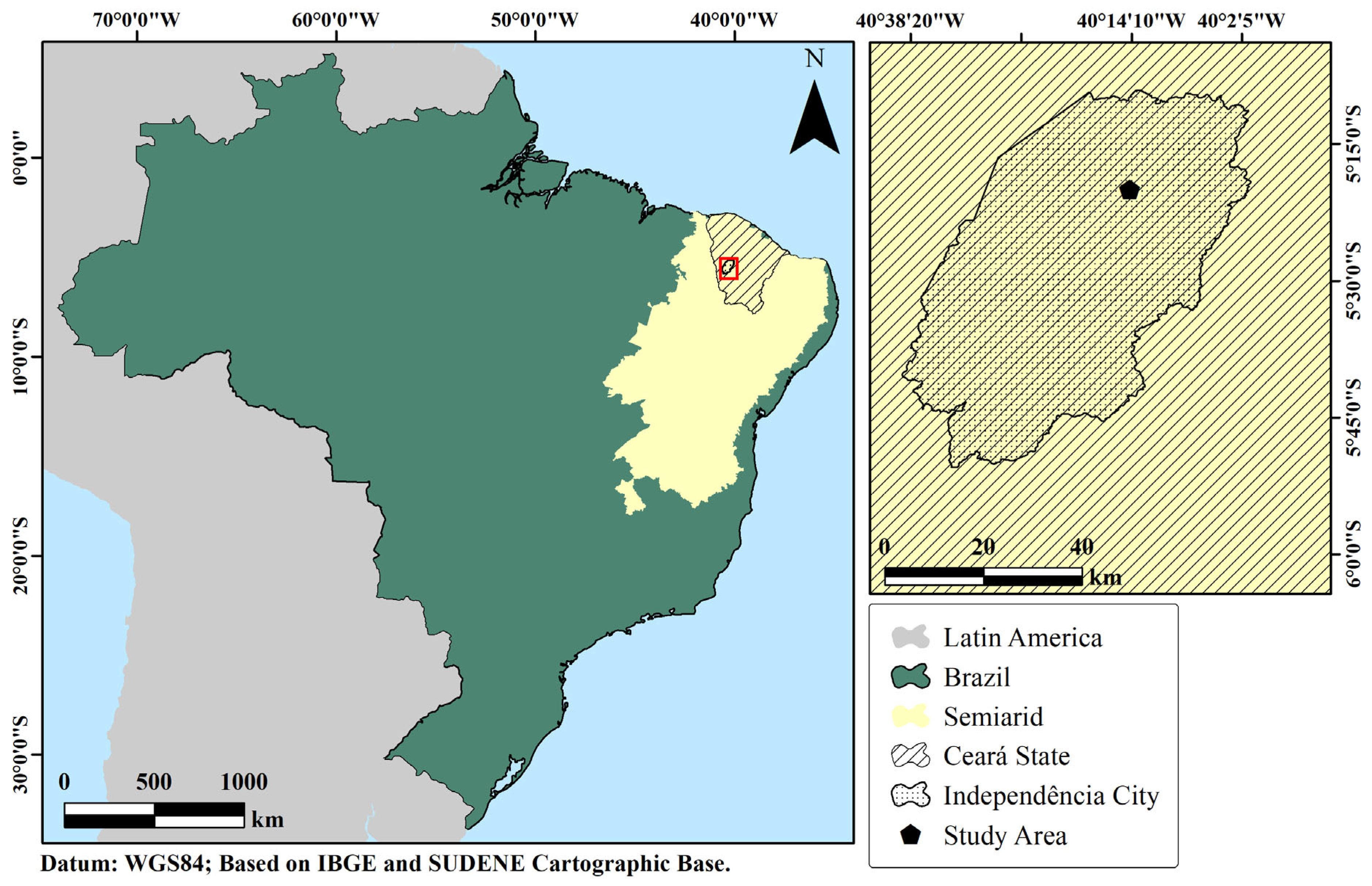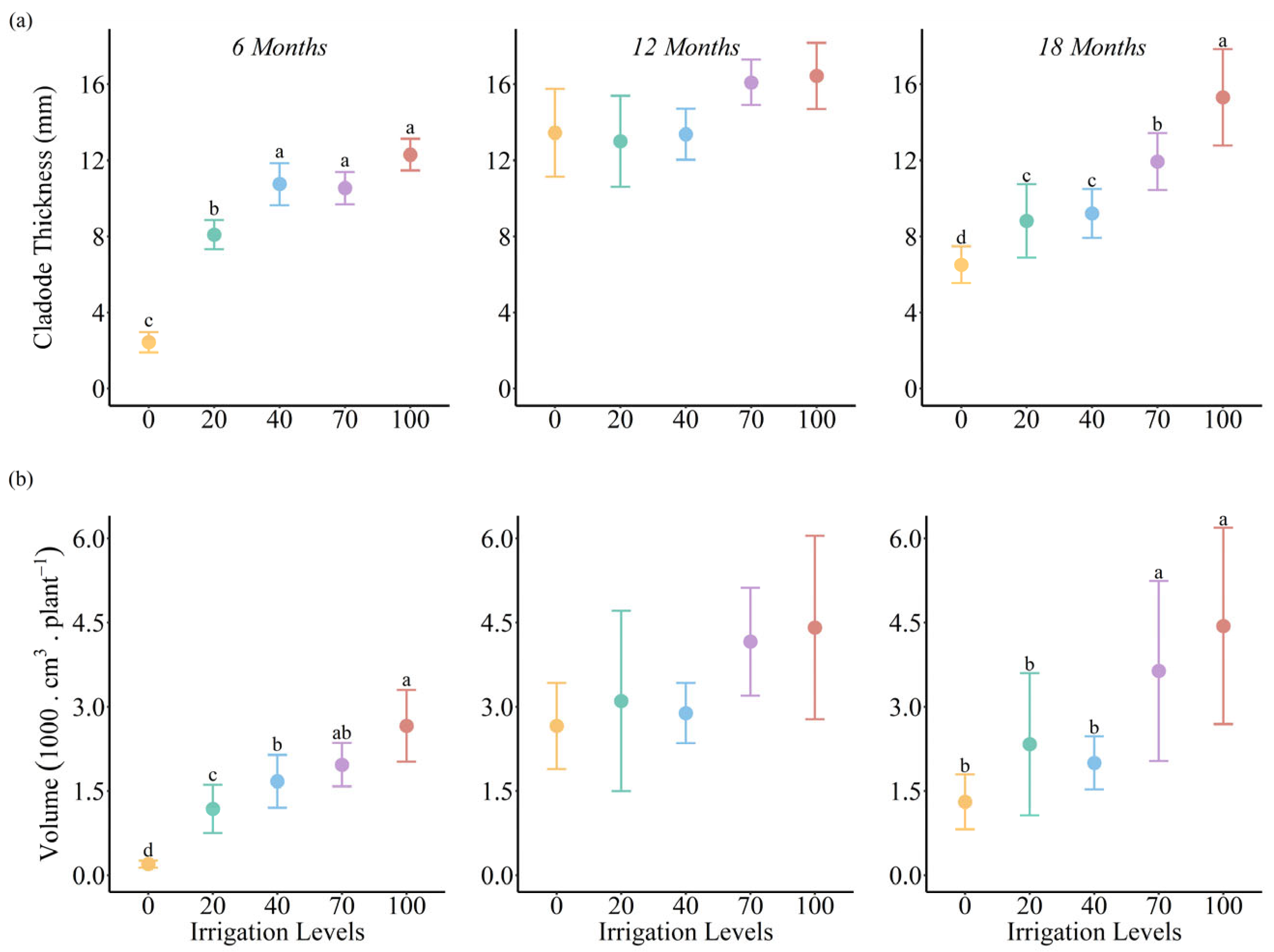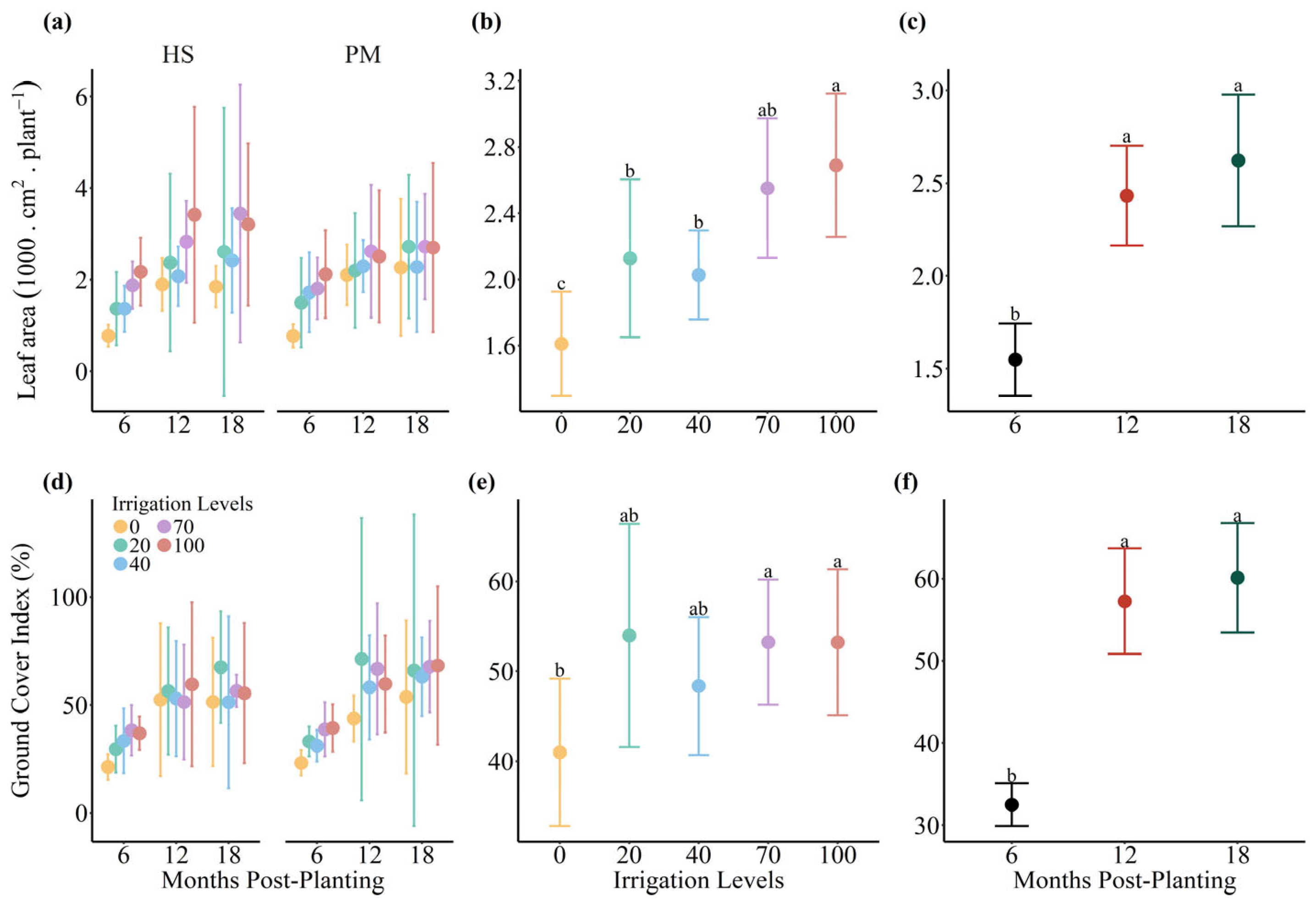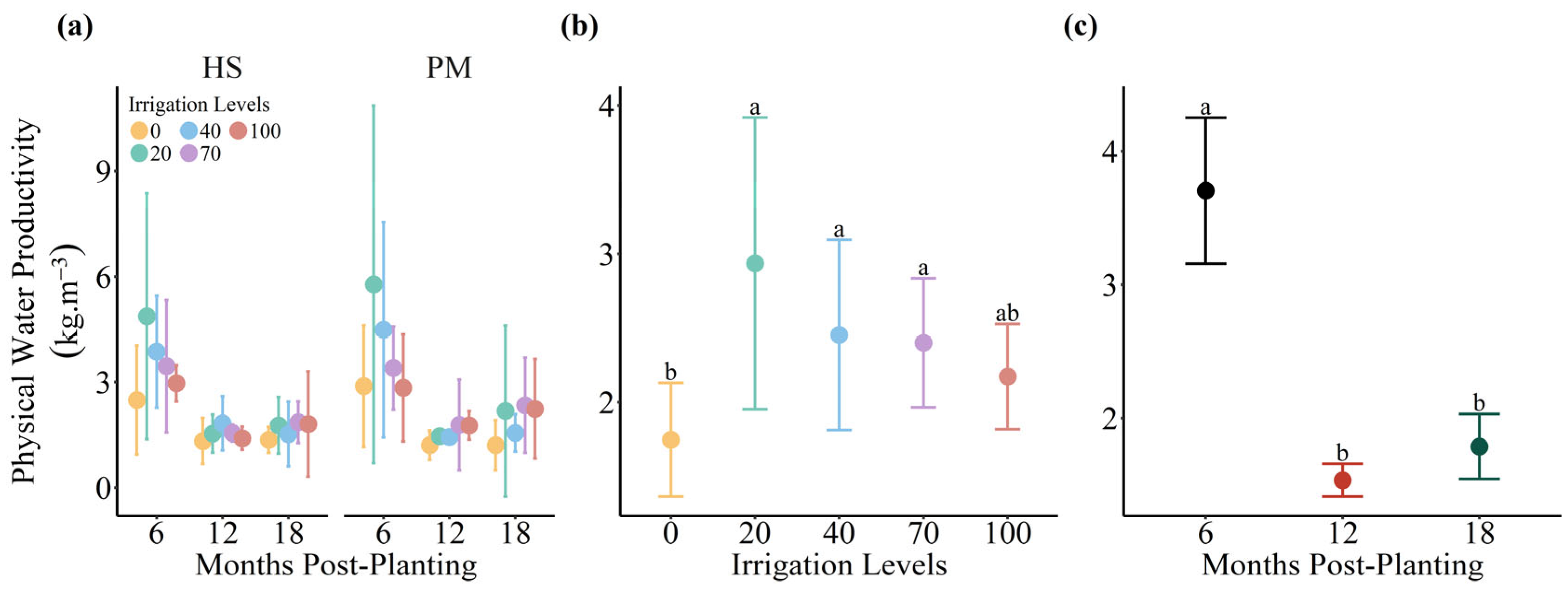Deficit Irrigation of Forage Cactus (Opuntia stricta) with Brackish Water: Impacts on Growth, Productivity, and Economic Viability under Evapotranspiration-Based Management
Abstract
:1. Introduction
2. Materials and Methods
2.1. Study Area
2.2. Irrigation Levels
2.3. Crop Evaluating Performance
2.4. Statistical Analysis
2.5. Economic Analysis
3. Results
3.1. Crop Performance
3.2. Economic Analysis
4. Discussion
4.1. Crop Performance
4.2. Economic Analysis
5. Conclusions
Author Contributions
Funding
Data Availability Statement
Acknowledgments
Conflicts of Interest
References
- Sequeira, T.N.; Santos, M.S.; Magalhães, M. Climate Change and Economic Growth: A Heterogeneous Panel Data Approach. Environ. Sci. Pollut. Res. 2018, 25, 22725–22735. [Google Scholar] [CrossRef]
- Stocker, T.F.; Qin, D.; Plattner, G.K.; Tignor, M.; Allen, S.K. Contribution of Working Group I to the Fifth Assessment Report of the Intergovernmental Panel on Climate Change; Intergovernmental panel on climate change, 2013: The Physical Science Basis; Cambridge University Press: New York, NY, USA, 2013; p. 1535. Available online: https://scholar.google.com/scholar_lookup?title=Intergovernmental+panel+on+climate+change&author=TF+Stocker&publication_year=2013 (accessed on 28 June 2024).
- Melero-Meraz, V.; Zegbe, J.A.; Herrera, M.D.; Guzmán-Maldonado, S.H.; Medina-García, G.; Sánchez-Toledano, B.I.; Cruz-Bravo, R.K.; Servín-Palestina, M. On-Farm Supplemental Irrigation of ‘Roja Lisa’ Cactus Pear: Pre- and Postharvest Effects. Horticulturae 2022, 8, 483. [Google Scholar] [CrossRef]
- Nhemachena, C.; Nhamo, L.; Matchaya, G.; Nhemachena, C.R.; Muchara, B.; Karuaihe, S.T.; Mpandeli, S. Climate Change Impacts on Water and Agriculture Sectors in Southern Africa: Threats and Opportunities for Sustainable Development. Water 2020, 12, 2673. [Google Scholar] [CrossRef]
- Pereira, L.S. Water and Agriculture: Facing Water Scarcity and Environmental Challenges. Agric. Eng. Int. CIGR J. 2005, 7, 26. [Google Scholar]
- Kisi, O.; Alizamir, M. Modelling Reference Evapotranspiration Using a New Wavelet Conjunction Heuristic Method: Wavelet Extreme Learning Machine vs Wavelet Neural Networks. Agric. For. Meteorol. 2018, 263, 41–48. [Google Scholar] [CrossRef]
- Flores-Velazquez, J.; Akrami, M.; Villagrán, E. The Role of Radiation in the Modelling of Crop Evapotranspiration from Open Field to Indoor Crops. Agronomy 2022, 12, 2593. [Google Scholar] [CrossRef]
- Xiang, K.; Li, Y.; Horton, R.; Feng, H. Similarity and Difference of Potential Evapotranspiration and Reference Crop Evapotranspiration—A Review. Agric. Water Manag. 2020, 232, 106043. [Google Scholar] [CrossRef]
- Rodrigues, G.C.; Braga, R.P. A Simple Application for Computing Reference Evapotranspiration with Various Levels of Data Availability—ETo Tool. Agronomy 2021, 11, 2203. [Google Scholar] [CrossRef]
- Allen, R.G.; Pereira, L.S.; Raes, D.; Smith, M. Crop Evapotranspiration-Guidelines for Computing Crop Water Requirements-FAO Irrigation and Drainage Paper 56. Fao Rome 1998, 300, D05109. [Google Scholar]
- Ahmadi, S.H.; Javanbakht, Z. Assessing the Physical and Empirical Reference Evapotranspiration (ETo) Models and Time Series Analyses of the Influencing Weather Variables on ETo in a Semi-Arid Area. J. Environ. Manag. 2020, 276, 111278. [Google Scholar] [CrossRef]
- Tigkas, D.; Vangelis, H.; Tsakiris, G. Implementing Crop Evapotranspiration in RDI for Farm-Level Drought Evaluation and Adaptation under Climate Change Conditions. Water Resour. Manag. 2020, 34, 4329–4343. [Google Scholar] [CrossRef]
- Derakhshandeh, M.; Tombul, M. Calibration of Metric Modeling for Evapotranspiration Estimation Using Landsat 8 Imagery Data. Water Resour. Manag. 2022, 36, 315–339. [Google Scholar] [CrossRef]
- Trajkovic, S. Temperature-Based Approaches for Estimating Reference Evapotranspiration. J. Irrig. Drain Eng. 2005, 131, 316–323. [Google Scholar] [CrossRef]
- Allen, R.G.; Pruitt, W.O.; Wright, J.L.; Howell, T.A.; Ventura, F.; Snyder, R.; Itenfisu, D.; Steduto, P.; Berengena, J.; Yrisarry, J.B.; et al. A Recommendation on Standardized Surface Resistance for Hourly Calculation of Reference ETo by the FAO56 Penman-Monteith Method. Agric. Water Manag. 2006, 81, 1–22. [Google Scholar] [CrossRef]
- Adeboye, O.B.; Osunbitan, J.A.; Adekalu, K.O.; Okunade, D.A. Evaluation of FAO-56 Penman-Monteith and Temperature Based Models in Estimating Reference Evapotranspiration Using Complete and Limited Data, Application to Nigeria. Agric. Eng. Int. CIGR J. 2009, 11, 25. [Google Scholar]
- Sentelhas, P.C.; Gillespie, T.J.; Santos, E.A. Evaluation of FAO Penman–Monteith and Alternative Methods for Estimating Reference Evapotranspiration with Missing Data in Southern Ontario, Canada. Agric. Water Manag. 2010, 97, 635–644. [Google Scholar] [CrossRef]
- Yong, S.L.S.; Ng, J.L.; Huang, Y.F.; Ang, C.K. Estimation of Reference Crop Evapotranspiration with Three Different Machine Learning Models and Limited Meteorological Variables. Agronomy 2023, 13, 1048. [Google Scholar] [CrossRef]
- Michelon, N.; Pennisi, G.; Myint, N.O.; Orsini, F.; Gianquinto, G. Strategies for Improved Water Use Efficiency (WUE) of Field-Grown Lettuce (Lactuca sativa L.) under a Semi-Arid Climate. Agronomy 2020, 10, 668. [Google Scholar] [CrossRef]
- Rodrigues, G.C.; Braga, R.P. Estimation of Daily Reference Evapotranspiration from NASA POWER Reanalysis Products in a Hot Summer Mediterranean Climate. Agronomy 2021, 11, 2077. [Google Scholar] [CrossRef]
- Ling, Z.; Shi, Z.; Xia, T.; Gu, S.; Liang, J.; Xu, C.-Y. Short-Term Evapotranspiration Forecasting of Rubber (Hevea brasiliensis) Plantations in Xishuangbanna, Southwest China. Agronomy 2023, 13, 1013. [Google Scholar] [CrossRef]
- Frizzone, J.A.; Lima, S.C.R.V.; Lacerda, C.F.; Mateos, L. Socio-Economic Indexes for Water Use in Irrigation in a Representative Basin of the Tropical Semiarid Region. Water 2021, 13, 2643. [Google Scholar] [CrossRef]
- Júnior, J.D.; Filho, J.A.; Santos, M.; Lira, M.; Santos, D.; Pessoa, R. Adubação Mineral No Crescimento e Composição Mineral Da Palma Forrageira-Clone IPA-201. Rev. Bras. De Ciências Agrárias 2010, 5, 129–135. [Google Scholar] [CrossRef]
- Ramos, J.P.D.F.; Leite, M.L.D.M.V.; Junior, S.D.O.; do Nascimento, J.P.; Santos, E.M. Crescimento Vegetativo de Opuntia ficus-indica Em Diferentes Espaçamentos de Plantio. Rev. Caatinga 2011, 24, 41–48. [Google Scholar]
- Kumar, S.; Louhaichi, M.; Dana Ram, P.; Tirumala, K.K.; Ahmad, S.; Rai, A.K.; Sarker, A.; Hassan, S.; Liguori, G.; Probir Kumar, G.; et al. Cactus Pear (Opuntia ficus-indica) Productivity, Proximal Composition and Soil Parameters as Affected by Planting Time and Agronomic Management in a Semi-Arid Region of India. Agronomy 2021, 11, 1647. [Google Scholar] [CrossRef]
- Alves, H.K.M.N.; Silva, T.G.F.D.; Jardim, A.M.D.R.F.; De Souza, L.S.B.; Araújo Júnior, G.D.N.; De Souza, C.A.A.; De Moura, M.S.B.; De Araújo, G.G.L.; Campos, F.S.; Da Cruz Neto, J.F. The Use of Mulch in Cultivating the Forage Cactus Optimizes Yield in Less Time and Increases the Water Use Efficiency of the Crop. Irrig. Drain. 2023, 72, 75–89. [Google Scholar] [CrossRef]
- Pereira, M.C.D.A.; de Azevedo, C.A.V.; Neto, J.D.; Pereira, M.d.O.; Ramos, J.G.; Nunes, K.G.; Lyra, G.B.; Saboya, L.M.F. Production of Forage Palm Cultivars (Orelha de Elefante Mexicana, IPA-Sertânia and Miúda) under Different Salinity Levels in Irrigation Water. Aust. J. Crop Sci. 2021, 15, 977–982. [Google Scholar] [CrossRef]
- Castro, I.N.D.; Santos, S.R.D.; Kondo, M.K.; Maia, V.M.; Santos, C.C.R.D. Agronomic performance and water use efficiency of irrigated Cactus Pear cultivars. Rev. Caatinga 2020, 33, 529–540. [Google Scholar] [CrossRef]
- Cruz Neto, J.F.D.; Morais, J.E.F.D.; Souza, C.A.A.D.; Carvalho, H.F.D.S.; Rodrigues, C.T.A.; Silva, T.G.F.D. Aplicabilidade de Indicadores Agrometeorológicos Para Análise Do Incremento de Água Por Irrigação Em Sistemas de Produção Da Palma Forrageira, Cv. Miúda. J. Env. Anal. Progr. 2017, 2, 98–106. [Google Scholar] [CrossRef]
- Flores-Hernández, A.; Orona-Castillo, I.; Murillo-Amador, B.; Garcia-Hernandez, J.L.; Troyo-Dieguez, E. Yield and Physiological Traits of Prickly Pear Cactus ‘Nopal’ (Opuntia Spp.) Cultivars under Drip Irrigation. Agric. Water Manag. 2004, 70, 97–107. [Google Scholar] [CrossRef]
- Freitas Campos, A.R.; Pereira Da Silva, A.J.; De Jong Van Lier, Q.; Lima Do Nascimento, F.A.; Miranda Fernandes, R.D.; Nunes De Almeida, J.; Pedro Da Silva Paz, V. Yield and Morphology of Forage Cactus Cultivars under Drip Irrigation Management Based on Soil Water Matric Potential Thresholds. J. Arid. Environ. 2021, 193, 104564. [Google Scholar] [CrossRef]
- Queiroz, M.G.D.; Silva, T.G.F.D.; Zolnier, S.; Silva, S.M.S.E.; Lima, L.R.; Alves, J.D.O. Características Morfofisiológicas e Produtividade Da Palma Forrageira Em Diferentes Lâminas de Irrigação. Rev. Bras. Eng. Agricola E Ambient. 2015, 19, 931–938. [Google Scholar] [CrossRef]
- de Araujo, G.G.; Silva, T.G.; Campos, F.S.; Silva, T.G.F.; Uast, S.T.P.; Fleming, S.C. Agricultura Biossalina e Uso de Águas Salobras Na Produção de Forragem. 2021. In Agricultura Irrigada em Ambientes Salinos; Cerqueira, P.R.S., Lacerda, C.F., Araujo, G.L., Gheyi, H.R., Simões, W.L., Eds.; Companhia de Desenvolvimento dos Vales do São Francisco e Parnaíba: Brasília, Brazil, 2021; p. 363. [Google Scholar]
- Dantas, F.D.G.; dos Santos, M.V.F.; Lima, G.F.d.C.; Coêlho, J.J.; de Medeiros, J.F.; da Cunha, M.V. Drip Irrigation with Saline Water Combined with Mulch Cover as Strategies for Forage Cactus Production in Semi-Arid Zones. Irrig. Sci. 2023, 41, 295–308. [Google Scholar] [CrossRef]
- Fonseca, V.A.; Santos, M.R.D.; Silva, J.A.D.; Donato, S.L.R.; Santos Rodrigues, C.; Brito, C.F.B. Morpho-Physiology, Yield, and Water-Use Efficiency of Opuntia ficus-indica Irrigated with Saline Water. Acta Sci. Agron. 2019, 41, 42631. [Google Scholar] [CrossRef]
- Lessa, C.I.N.; De Lacerda, C.F.; Cajazeiras, C.C.D.A.; Neves, A.L.R.; Lopes, F.B.; Silva, A.O.D.; Sousa, H.C.; Gheyi, H.R.; Nogueira, R.D.S.; Lima, S.C.R.V.; et al. Potential of Brackish Groundwater for Different Biosaline Agriculture Systems in the Brazilian Semi-Arid Region. Agriculture 2023, 13, 550. [Google Scholar] [CrossRef]
- Koppen, W. Das Geographische System de Klimate. In Handbuch der Klimatologie; Gebrüder Borntraeger: Berlin, Germany, 1936; p. 44. [Google Scholar]
- Alvares, C.A.; Stape, J.L.; Sentelhas, P.C.; De Moraes Gonçalves, J.L.; Sparovek, G. Köppen’s Climate Classification Map for Brazil. Meteorol. Z. 2013, 22, 711–728. [Google Scholar] [CrossRef]
- Saraiva, F.M. Desenvolvimento e Acúmulo de Nutrientes de Palma Forrageira (Nopalea) em Diferentes Sistemas de Cultivo. Master’s Thesis, Universidade Federal Rural de Pernambuco, Recife, Brazil, 2014; p. 104. [Google Scholar]
- Salassier, B.; Soares, A.A.; Mantovani, E.C. Manual de Irrigação; Universidade Federal de Viçosa: Viçosa, Brazil, 2006. [Google Scholar]
- Reichardt, K.; Timm, L.C. Solo, Planta e Atmosfera: Conceitos, Processos e Aplicações; Manole: Barueri, Brazil, 2004. [Google Scholar]
- Snyman, H.A. Root Distribution with Changes in Distance and Depth of Two-Year-Old Cactus Pears Opuntia ficus-indica and O. robusta Plants. South Afr. J. Bot. 2006, 72, 434–441. [Google Scholar] [CrossRef]
- Crop Ecology, Cultivation and Uses of Cactus Pear, Final version; Inglese, P.; Mondragón-Jacobo, C.; Nefzaoui, A.; Sáenz, H.C. (Eds.) Food and Agriculture Organization of the United Nations, International Center for Agricultural Research in the Dry Areas: Rome, Italy, 2017. [Google Scholar]
- Mantovani, E.; Bernardo, S.; Palaretti, L. Irrigação: Princípios e Métodos. Atual; UFV: Viçosa, Brazil, 2009. [Google Scholar]
- Queiroz, M.G.D.; Silva, T.G.F.D.; Zolnier, S.; Silva, S.M.S.E.; Souza, C.A.A.D.; Carvalho, H.F.D.S. Relações hídrico-econômicas da Palma Forrageira cultivada em ambiente semiárido. Irriga 2018, 1, 141. [Google Scholar] [CrossRef]
- Hargreaves, G.H.; Samani, Z.A. Reference Crop Evapotranspiration from Temperature. Appl. Eng. Agric. 1985, 1, 96–99. [Google Scholar] [CrossRef]
- Silva, T.; Miranda, K.; Santos, D.; Queiroz, M.; Silva, M.; Neto, J.C.; Araújo, J. Área do Cladódio de Clones de Palma Forrageira: Modelagem, análise e aplicabilidade. Rev. Bras. Ciências Agrárias 2014, 9, 633–641. [Google Scholar] [CrossRef]
- Cavalcante, E.S.; Lacerda, C.F.D.; Costa, R.N.T.; Gheyi, H.R.; Pinho, L.L.; Bezerra, F.M.S.; Oliveira, A.C.D.; Canjá, J.F. Supplemental Irrigation Using Brackish Water on Maize in Tropical Semi-Arid Regions of Brazil: Yield and Economic Analysis. Sci. Agric. 2021, 78 (Suppl. S1), e20200151. [Google Scholar] [CrossRef]
- Neto, B.S.; Dezen, M.; dos Santos, P.E. O Conceito de Reprodução Social Na Análise de Unidades de Produção Agropecuária. Rev. Teor. E Evidência Econômica 2009, 15. [Google Scholar]
- Scalisi, A.; Morandi, B.; Inglese, P.; Lo Bianco, R. Cladode Growth Dynamics in Opuntia ficus-indica under Drought. Environ. Exp. Bot. 2016, 122, 158–167. [Google Scholar] [CrossRef]
- Pereira, P.D.C.; Silva, T.G.F.D.; Zolnier, S.; Silva, S.M.S.E.; Silva, M.J.D. Water balance in soil cultivated with Forage Cactus clones under irrigation. Rev. Caatinga 2017, 30, 776–785. [Google Scholar] [CrossRef]
- Lee, J.S. Stomatal Opening Mechanism of CAM Plants. J. Plant Biol. 2010, 53, 19–23. [Google Scholar] [CrossRef]
- Silva, T.G.F.D.; Primo, J.T.A.; Moura, M.S.B.D.; Silva, S.M.S.E.; Morais, J.E.F.D.; Pereira, P.D.C.; Souza, C.A.A.D. Soil Water Dynamics and Evapotranspiration of Forage Cactus Clones under Rainfed Conditions. Pesq. Agropec. Bras. 2015, 50, 515–525. [Google Scholar] [CrossRef]
- Barbosa, M.L.; Silva, T.G.F.D.; Zolnier, S.; Silva, S.M.S.E.; Araújo, G.D.N., Jr.; Jardim, A.M.D.R.F. Meteorological Variables and Morphological Characteristics Influencing the Evapotranspiration of Forage Cactus. Rev. Ceres 2017, 64, 465–475. [Google Scholar] [CrossRef]
- De Alencar, L.P.; Delgado, R.C.; Almeida, T.S.; Wanderley, H.S. Comparação de Diferentes Métodos de Estimativa Diária Da Evapotranspiração de Referência Para a Região de Uberaba. Rev. Bras. Ciências Agrárias 2011, 6, 337–343. [Google Scholar] [CrossRef]
- Shahidian, S.; Serralheiro, R.P.; Serrano, J.; Teixeira, J.L. Parametric Calibration of the Hargreaves–Samani Equation for Use at New Locations. Hydrol. Process. 2013, 27, 605–616. [Google Scholar] [CrossRef]
- Bezerra, B.G.; Araújo, J.S.; Pereira, D.D.; Laurentino, G.Q.; Silva, L.L.D. Zoneamento Agroclimático da Palma Forrageira (Opuntia Sp.) para o Estado da Paraíba. Rev. Bras. De Eng. Agricola E Ambient. 2014, 18, 755–761. [Google Scholar] [CrossRef]
- Temesgen, B.; Allen, R.G.; Jensen, D.T. Adjusting Temperature Parameters to Reflect Well-Watered Conditions. J. Irrig. Drain Eng. 1999, 125, 26–33. [Google Scholar] [CrossRef]
- Xu, C.-Y.; Singh, V. Cross Comparison of Empirical Equations for Calculating Potential Evapotranspiration with Data from Switzerland. Water Resour. Manag. 2002, 16, 197–219. [Google Scholar] [CrossRef]
- Arraes, F.D.D.; Junior, J.C.L.; de Oliveira, J.B.; de Macêdo, K.G.; de Sousa Couras, Y.; de Oliveira, W.C. Parametrização Da Equação de Hargreaves-Samani Para o Estado Do Pernambuco–Brasil. Rev. Bras. De Agric. Irrig. RBAI 2016, 10, 410–419. [Google Scholar] [CrossRef]
- Rocha, R.; Voltolini, T.; Gava, C. Características Produtivas e Estruturais de Genótipos de Palma Forrageira Irrigada Em Diferentes Intervalos de Corte. Arch. De Zootec. 2017, 66, 365–373. [Google Scholar] [CrossRef]
- Pereira, J.D.S.; Cavalcante, A.B.; Simões, W.L.; Voltolini, T.V. Forage Yield, Structural Responses and Chemical Composition of Spineless Cactus Orelha de Elefante Mexicana in Different Water Depths and Irrigation Frequencies. Cienc. Rural 2021, 51, e20200324. [Google Scholar] [CrossRef]
- Gibson, A.C.; Nobel, P.S. The Cactus Primer; Harvard University Press: Cambridge, MA, USA, 2013. [Google Scholar] [CrossRef]
- Drennan, P.M.; Nobel, P.S. Root Growth Dependence on Soil Temperature for Opuntia ficus-indica: Influences of Air Temperature and a Doubled CO2 Concentration. Funct. Ecol. 1998, 12, 959–964. [Google Scholar] [CrossRef]
- Rykaczewski, K.; Jordan, J.S.; Linder, R.; Woods, E.T.; Sun, X.; Kemme, N.; Manning, K.C.; Cherry, B.R.; Yarger, J.L.; Majure, L.C. Microscale Mechanism of Age Dependent Wetting Properties of Prickly Pear Cacti (Opuntia). Langmuir 2016, 32, 9335–9341. [Google Scholar] [CrossRef]
- Kim, H.; Kim, K.; Lee, S.J. Hydraulic Strategy of Cactus Root–Stem Junction for Effective Water Transport. Front. Plant Sci. 2018, 9, 799. [Google Scholar] [CrossRef]
- Rieger, M.; Litvin, P. Root System Hydraulic Conductivity in Species with Contrasting Root Anatomy. J. Exp. Bot. 1999, 50, 201–209. [Google Scholar] [CrossRef]
- Nobel, P.S. Environmental Biology of Agaves and Cacti; Cambridge University Press: Cambridge, UK, 2003. [Google Scholar]
- Ju, J.; Bai, H.; Zheng, Y.; Zhao, T.; Fang, R.; Jiang, L. A Multi-Structural and Multi-Functional Integrated Fog Collection System in Cactus. Nat. Commun. 2012, 3, 1247. [Google Scholar] [CrossRef]
- Kim, K.; Kim, H.; Ho Park, S.; Joon Lee, S. Hydraulic Strategy of Cactus Trichome for Absorption and Storage of Water under Arid Environment. Front. Plant Sci. 2017, 8, 1777. [Google Scholar] [CrossRef] [PubMed]
- Silva, T.G.F.; Primo, J.T.A.; Silva, S.M.S.E.; Moura, M.S.B.D.; Santos, D.C.D.; Silva, M.D.C.; Araújo, J.E.M. Indicadores de Eficiência Do Uso Da Água e de Nutrientes de Clones de Palma Forrageira Em Condições de Sequeiro No Semiárido Brasileiro. Bragantia 2014, 73, 184–191. [Google Scholar] [CrossRef]
- de Souza, L.; de Moura, M.; da Silva, T.; Soares, J.; do Carmo, J.; Brandão, E. Indicadores Climáticos Para o Zoneamento Agrícola Da Palma Forrageira (Opuntia Sp.). In Jornada de Iniciação Científica da Embrapa Semi-Árido; Embrapa Semi-Árido: Petrolina, Brazil, 2008. [Google Scholar]
- Voltolini, T. Sistema de Produção de Palma-Forrageira para o Estado da Paraíba; Embrapa Semiárido: Petrolina, Brazil, 2022. [Google Scholar]
- Sánchez-Toledano, B.I.; Zegbe, J.A. Economic Indices for the Application of Irrigation to Enhance Cactus Pear Fruit Yield. Asian J. Agric. Ext. Econ. Sociol. 2021, 39, 73–81. [Google Scholar] [CrossRef]
- Silva Neto, B. Agroecologia e análise econômica de sistemas de produção. In Uma Abordagem Baseada no Materialismo Histórico e Dialético; Universidade Federal da Fronteira Sul—UFFS: Chapecó, Brazil, 2016. [Google Scholar]








| Equation | TRI (%) | 6 Months | 12 Months | 18 Months | Cumulated | Cumulated | |||
|---|---|---|---|---|---|---|---|---|---|
| I | P | I | P | I | P | I | P | ||
| Mm | |||||||||
| 0 | 0 | 28.8 | 0 | 722.2 | 0 | 69.0 | 0 | 820.0 | |
| PM | 100 | 353.2 | 28.8 | 71.3 | 722.2 | 315.6 | 69.0 | 740.1 | 820.0 |
| 70 | 247.3 | 28.8 | 49.9 | 722.2 | 220.8 | 69.0 | 518.0 | 820.0 | |
| 40 | 141.3 | 28.8 | 28.5 | 722.2 | 126.2 | 69.0 | 296.0 | 820.0 | |
| 20 | 70.6 | 28.8 | 14.3 | 722.2 | 63.1 | 69.0 | 148.0 | 820.0 | |
| HS | 100 | 315.6 | 28.8 | 56.5 | 722.2 | 277.9 | 69.0 | 650.0 | 820.0 |
| 70 | 220.9 | 28.8 | 39.6 | 722.2 | 194.5 | 69.0 | 455.6 | 820.0 | |
| 40 | 126.2 | 28.8 | 22.6 | 722.2 | 111.2 | 69.0 | 260.2 | 820.0 | |
| 20 | 63.1 | 28.8 | 11.3 | 722.2 | 55.6 | 69.0 | 130.0 | 820.0 | |
| Discrimination | %TRI | ||||
|---|---|---|---|---|---|
| Fixed Cost (BRL) | 100 | 70 | 40 | 20 | 0 |
| Irrigation | 11,150.95 | 11,150.95 | 11,150.95 | 11,150.95 | 0.00 |
| Loan installment | 1115.11 | 0.00 | |||
| Discrimination | %TRI | ||||
|---|---|---|---|---|---|
| Variable Cost (BRL) | 100 | 70 | 40 | 20 | 0 |
| Organic Fertilizer | 10,199.98 | 10,199.98 | 10,199.98 | 10,199.98 | 10,199.98 |
| Cladodes Seeds | 12,083.41 | 12,083.41 | 12,083.41 | 12,083.41 | 12,083.41 |
| Electricity | 35.30 | 17.04 | 5.90 | 2.36 | 0.00 |
| Total | 22,318.69 | 22,300.43 | 22,289.29 | 22,285.75 | 22,283.39 |
| Financing installment | 2231.87 | 2230.04 | 2228.93 | 2228.58 | 2228.34 |
| Sources of Variation | DF | Pr (<F) | ||||||
|---|---|---|---|---|---|---|---|---|
| CT (mm) | CV/P (cm3 plant−1) | DMP (kg ha−1) | LA/P (cm2 plant−1) | SCI (%) | FMP (kg ha−1) | PWP_DM (kg m−3) | ||
| Equations (E) | 1 | 0.538 ns | 0.982 ns | 0.498 ns | 0.871 ns | 0.170 ns | 0.418849 ns | 0.511 ns |
| Irrigation Levels (L) | 4 | <0.001 ** | <0.001 ** | <0.001 ** | <0.001** | 0.008 ** | <0.001 ** | 0.002 ** |
| Time (T) | 2 | <0.001 ** | <0.001 ** | <0.001 ** | <0.001 ** | <0.001 ** | <0.001 ** | <0.001 ** |
| Blocks | 3 | 0.144 ns | 0.0065 ** | 0.143 ns | 0.003 ** | 0.122 ns | 0.0012 ** | 0.143 ns |
| E × L | 4 | 0.762 ns | 0.454 ns | 0.882 ns | 0.528 ns | 0.923 ns | 0.697 ns | 0.873 ns |
| E × T | 2 | 0.542 ns | 0.972 ns | 0.605 ns | 0.849 ns | 0.905 ns | 0.913 ns | 0.870 ns |
| L × T | 8 | <0.001 ** | <0.001 ** | <0.001 ** | 0.155 ns | 0.780 ns | 0.611 ns | 0.159 ns |
| E × L × T | 8 | 0.858 | 0.987 ns | 0.968 ns | 0.987 ns | 0.888 ns | 0.939 ns | 0.929 ns |
| Residual | 90 | - | - | - | - | - | - | - |
| CV (%) | 7.62 | 5.59 | 3.75 | 4.27 | 8.38 | 33.03 | 11.55 | |
Disclaimer/Publisher’s Note: The statements, opinions and data contained in all publications are solely those of the individual author(s) and contributor(s) and not of MDPI and/or the editor(s). MDPI and/or the editor(s) disclaim responsibility for any injury to people or property resulting from any ideas, methods, instructions or products referred to in the content. |
© 2024 by the authors. Licensee MDPI, Basel, Switzerland. This article is an open access article distributed under the terms and conditions of the Creative Commons Attribution (CC BY) license (https://creativecommons.org/licenses/by/4.0/).
Share and Cite
Bezerra, F.M.S.; de Lacerda, C.F.; Giroldo, A.B.; Cavalcante, E.S.; Michelon, N.; Pennisi, G.; Sales, J.R.d.S.; Lessa, C.I.N.; Lima, S.C.R.V.; Lopes, F.B.; et al. Deficit Irrigation of Forage Cactus (Opuntia stricta) with Brackish Water: Impacts on Growth, Productivity, and Economic Viability under Evapotranspiration-Based Management. Agronomy 2024, 14, 1445. https://doi.org/10.3390/agronomy14071445
Bezerra FMS, de Lacerda CF, Giroldo AB, Cavalcante ES, Michelon N, Pennisi G, Sales JRdS, Lessa CIN, Lima SCRV, Lopes FB, et al. Deficit Irrigation of Forage Cactus (Opuntia stricta) with Brackish Water: Impacts on Growth, Productivity, and Economic Viability under Evapotranspiration-Based Management. Agronomy. 2024; 14(7):1445. https://doi.org/10.3390/agronomy14071445
Chicago/Turabian StyleBezerra, Francisco Mardones Servulo, Claudivan Feitosa de Lacerda, Aelton Biasi Giroldo, Eduardo Santos Cavalcante, Nicola Michelon, Giuseppina Pennisi, Jonnathan Richeds da Silva Sales, Carla Ingryd Nojosa Lessa, Silvio Carlos Ribeiro Vieira Lima, Fernando Bezerra Lopes, and et al. 2024. "Deficit Irrigation of Forage Cactus (Opuntia stricta) with Brackish Water: Impacts on Growth, Productivity, and Economic Viability under Evapotranspiration-Based Management" Agronomy 14, no. 7: 1445. https://doi.org/10.3390/agronomy14071445






